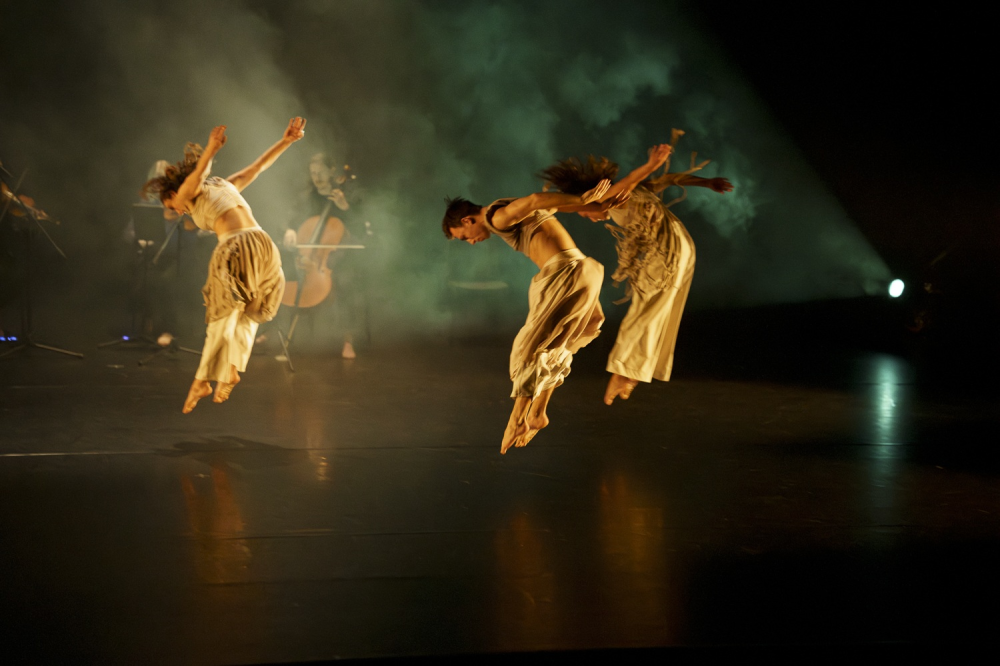Soundings Theatre, Museum of New Zealand Te Papa Tongarewa
Wellington
6 April 2025
Choreography, Spatial & Costume Design: Moss Te Ururangi Patterson
Lighting Design: Ella Madsen
Music Direction: Mark La Roche
Reviewed by Brigitte Knight

Photos by John McDermott
Concluding their three-centre tour in the capital, a collaboration between the New Zealand Dance Company, New Zealand String Quartet, and Chamber Music New Zealand presents 100 Winds Taupō Hau Rau to a capacity audience at Te Papa's Soundings Theatre. Set to the minimalist music of American composers Philip Glass and Steve Reich, the musicians of New Zealand String Quartet are balanced with the New Zealand Dance Company’s four dancers. 100 Winds Taupō Hau Rau seeks to draw together an expansive range of influences, concepts, themes, and images and the finished production is calming, hypnotic, continuous, and gently evolving.
NZDC Chief Executive, Artistic Director and Choreographer Moss Te Ururangi Patterson’s (Ngāti Tūwharetoa) concept for 100 Winds Taupō Hau Rau builds and expands upon his existing body of work, with connections to the natural world, Te Ao Māori, Lake Taupō, and in particular his visual and aural memories of Waihi Village, Tokaanu, on the southern edge of the great lake. Website notes offer additional conceptual detail to the programme, and describe that the work is
“...rooted in a deep connection to the land and winds of Lake Taupō, 100 Winds uses the metaphor of wind...to explore the shifting cultural, political, and social currents within New Zealand’s Māori and Pākehā communities. The performance draws from the historical and symbolic significance of the region’s 100 winds, representing the diverse and often turbulent forces that shape our lives...It examines how individuals and society can remain centred and hold onto core values during times of significant change...100 Winds aims to foster a deeper conversation about our collective past and present, encouraging audiences to reflect on how we navigate the winds of change while honouring our shared heritage...”

At times this concept feels distant from Glass’ modernist American material, especially when considering the composer’s own inspiration and intentions for his works − a dramatisation of Samuel Beckett’s short novel Company by avant-garde New York theatre company Mabou Mines (String Quartet No. 2 Company); sections of the film score for Mishima: A Life in Four Chapters by film maker Paul Schrader about the infamous and radical Japanese author Yukio Mishima (String Quartet No. 3 Mishima); and a commission by the partner of American visual artist Brian Buczak for the memorial of the artist’s death from AIDS-related complications at the age of 32, in which Glass strove to create a tribute to the artist’s life and work (String Quartet No. 4 Buczak). Glass’ music is a favourite of choreographers who are in no way bound by the composer’s own intentions, however, 100 Winds Taupō Hau Rau may have missed an opportunity for a more intimate connection between sound, meaning, and movement here, although the movement material certainly mirrors the sound world’s oscillating repetitive intention pioneered by the two composers.
The cross-pollination of art forms, audiences, and the exploration of the use of sound/movement/space is one of the many potential strengths of this kind of collaboration between dancers and musicians. 100 Winds Taupō Hau Rau opens with musicians set onstage, in this case seated upstage centre illuminated gently within an otherwise darkened stage. Formally dressed in black, but with bare feet, the NZSQ artists Peter Clark (Violin I), Monique Lapins (Violin II), Gillian Ansell (Viola), and Matthias Balzat (Cello) provide a brightly amplified version of Glass’ String Quartet No. 2, which is crisp, consistent, and rhythmically relaxing. Leading the transition in to Glass’ String Quartet No. 3 ‘Isope ‘Akau’ola wields a pūrerehua skillfully (with occasionally edgy proximity to the musicians, hanging microphones, and other dancers), bringing a new layer of sound to the performance, and establishing the circular movement motif which Patterson has woven throughout his work. Costumed in muted natural colours and textures, NZDC artists Eden Kew, Caterina Moreno, and Anya Down create an effective visual contrast with the Quartet musicians.

The four current NZDC dancers are particularly cohesive in their technique, physicality, and consistency, and each dancer is at ease with Patterson’s familiar movement vocabulary fusing fluidly contemporary dance and kapa haka. Throughout their significant time onstage Kew, Moreno, and Down sustain strength and stamina that is almost flawless, with ‘Akau’ola delivering occasional yet delightful moments of even more rigorous speed and attack. A mesmeric effect is achieved through the combined elements of the Glass compositions, simple, low lighting, and Patterson’s use of floorwork with low-to-mid level transitions, which makes the audience's experience of 100 Winds Taupō Hau Rau relaxing and pleasant. Some entrances and transitions seem uncertain at times, and ensemble unison occasionally feels less deliberate and confident, perhaps reflective of combined rehearsal time with NZSQ or the altered run order for the Wellington performance.
The one composition by Reich is Clapping Music, a dynamic and demandingly swift percussive work that sees significantly increased integration between musicians and dancers. This change of tempo is refreshing in an otherwise very even-tempered production, and the audience responds with the most vigorous applause of the night. In Clapping Music Patterson and the Quartet begin to explore some of the more interesting and creative aspects of the collaboration, including the use of breath, performers focused inwards towards one another, and a closer connection between musical and choreographic intentions. Patterson’s extended metaphor of the 100 ever-shifting winds is easy to interpret in the lively movement of the dancers, and the (approximately) hour-long performance of 100 Winds Taupō Hau Rau delivers an enjoyable and positive theatrical experience. The collaboration between the New Zealand Dance Company, New Zealand String Quartet and Chamber Music New Zealand is an appealing new direction for Patterson, with fans of classical music and contemporary dance alike appreciative of this new offering.


